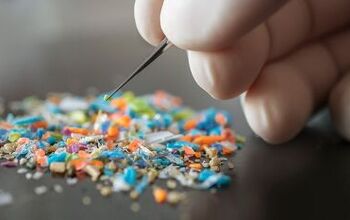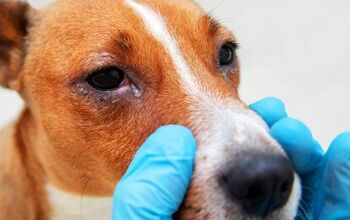All About Dog Anal Glands

Have you ever seen a dog scooting his butt across the floor and wondered what he is doing? Sometimes this can be a sign of intestinal parasites but, more often, it is due to a problem with the anal glands. Keep reading to learn more about common problems dog anal glands and to learn how to safely express them yourself.
Before you can understand common problems with anal sacs in dogs, you need to know what they are and what purpose they serve. As you can guess from the name, anal sacs are small sacs of fluid located between your dog’s internal and external anal sphincter muscles.
Related: The Sad, Scratchy Story Of Oscar’s Itchy Butt
These sacs contain an oily substance with a strong odor that is excreted along with the dog’s stool to leave his scent marker behind. This is why dogs often greet each other by sniffing butts – the anal sacs are what carry most of your dog’s unique scent. Some experts believe that the material in the anal sacs functions more as lubrication for stool, making it easier to pass.
Though they aren’t technically glands, anal sacs are similar in function and they can be affected by similar problems to other glands. Your dog’s anal sacs are prone to infection and they can become impacted or overfilled as well.
Related: Can You Guess A Dog Breed By His Butt?
For most dogs, the material in the anal sacs is semi-liquid but some dogs have a thicker anal sac material that is more prone to impaction. When the sacs become infected or inflamed, they may need to be drained either by hand or via a surgical procedure. Keep reading to learn how to express your dog’s anal glands on your own.
Expressing your dog’s anal glands is by no means a pleasant experience but it is necessary from time to time. Here is how you do it:
- Put on a pair of rubber gloves – you don’t want to do this with your bare hands.
- Fold up a few paper towels into a pad to absorb the expressed liquid.
- Gently lift your dog’s tail and place the pad of paper towels over his anus, covering the entire area.
- Through the paper towels, use your thumb and forefinger to gently squeeze together the two sides of your dog’s anus at the 4 o’clock and 8 o’clock positions.
- Use the paper towels to absorb all of the liquid then wash your dog’s anus with soap and water then dry it well.
- If this procedure does not yield any liquid or if your dog shows signs of pain or discomfort, the glands may be impacted and you should seek veterinary care.
It’s always better to prevent issues before they even happen instead of having to resort to treating them. If you want to avoid having to express your dog’s anal glands on a regular basis, you will have to introduce some lifestyle and diet changes that could help ensure their anal sacks don’t get overfilled and infected anymore.
- Diet Changes
Having a well-balanced, healthy diet is the foundation for your pet’s overall health. If they lack nutrients in their meals or don’t eat foods that are designed for their digestive system, trouble abounds- from poor GI health to weakened immune system, a bad diet can wreak havoc on your pet’s body, and that includes their anal glands as well. If your pet’s stool is too loose, it could be a sign that his diet is not up to standards or that he has certain food sensitivities that are causing chronic diarrhea or soft stools. Try switching to hypoallergenic dry dog food to see if it makes a difference or take your pet to a vet for allergy testing.
- Fiber Increase
The way most dogs eat these days, it’s difficult to pinpoint what’s lacking in their diets. If your pet is eating mostly or completely dry food, chances are that he’s nor getting enough fiber through his meals. Fiber helps to add bulk to his stool so that it naturally expresses the anal glands with each passing. Introducing healthy fibers from a quality digestive supplement can make a real difference. Added healthy fiber helps bulk up and create larger stools. The physical pressure from the larger stool passing naturally expresses fluids in your dog’s anal sacs every time they poop.
- Probiotics
You’d be surprised how much gut flora can have an impact on your pet’s overall wellbeing, let alone their digestive health- and in turn, anal glands. If the beneficial bacteria are not thriving in your pet’s gut and bad bacteria is overgrowing as a result, your pet will experience a range of different issues that can make it more likely for anal glands to get impacted, such as constipation or diarrhea. A good probiotic for dogs can sort all that in no time, and help your pet’s digestion be up to standards again and with it, its poop. When dogs are on probiotics, the texture of their stool should be optimal for the healthy functioning of anal glands which means firm enough to ensure your pet expresses the sacks the natural way- when he’s pooping.
- Weight Loss
Your pet doesn’t have to be obese for the excess weight to mess up the functioning of his anal sacs- even a few pounds of extra fluff could be to blame. One of the first steps to take when looking to improve your pet’s health and ensure proper function of anal glands is making sure he loses weight. Regular exercise and modifications in the diet have great results with obese and overweight dogs, and with a little patience and persistence, you will have no trouble helping your pooch be in the best form of his life.

Kate Barrington is the loving owner of two cats (Bagel and Munchkin) and a noisy herd of guinea pigs. Having grown up with golden retrievers, Kate has a great deal of experience with dogs but labels herself a lover of all pets. Having received a Bachelor's degree in English, Kate has combined her love for pets and her passion for writing to create her own freelance writing business, specializing in the pet niche.
More by Kate Barrington























